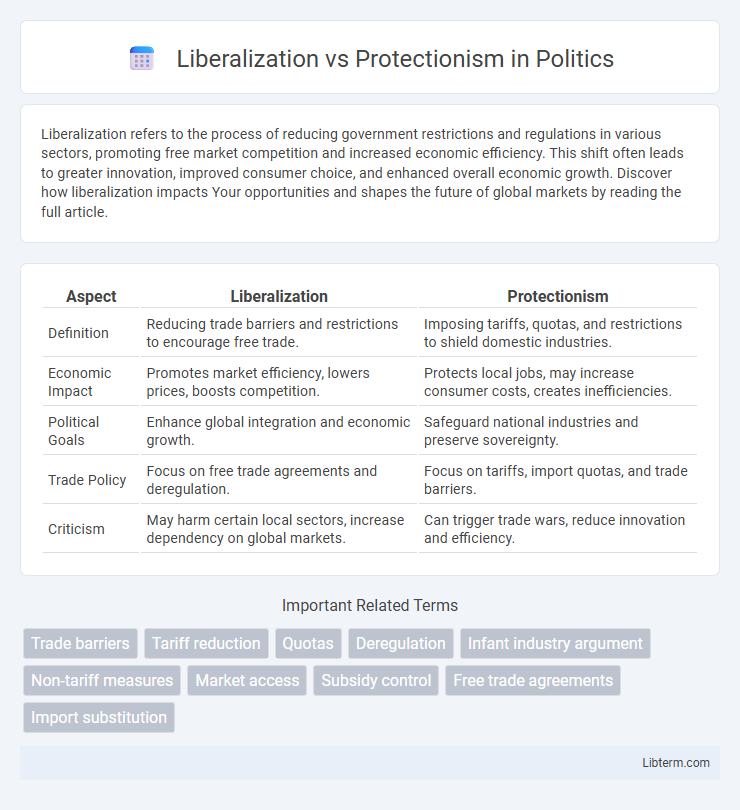Liberalization refers to the process of reducing government restrictions and regulations in various sectors, promoting free market competition and increased economic efficiency. This shift often leads to greater innovation, improved consumer choice, and enhanced overall economic growth. Discover how liberalization impacts Your opportunities and shapes the future of global markets by reading the full article.
Table of Comparison
| Aspect | Liberalization | Protectionism |
|---|---|---|
| Definition | Reducing trade barriers and restrictions to encourage free trade. | Imposing tariffs, quotas, and restrictions to shield domestic industries. |
| Economic Impact | Promotes market efficiency, lowers prices, boosts competition. | Protects local jobs, may increase consumer costs, creates inefficiencies. |
| Political Goals | Enhance global integration and economic growth. | Safeguard national industries and preserve sovereignty. |
| Trade Policy | Focus on free trade agreements and deregulation. | Focus on tariffs, import quotas, and trade barriers. |
| Criticism | May harm certain local sectors, increase dependency on global markets. | Can trigger trade wars, reduce innovation and efficiency. |
Understanding Liberalization: Definition and Key Principles
Liberalization refers to the process of reducing or eliminating government restrictions and regulations in economic activities, particularly in trade and investment. Key principles include promoting free markets, encouraging competition, and enhancing the flow of goods, services, and capital across borders to stimulate economic growth. This approach aims to increase efficiency, lower prices, and provide consumers with more choices by removing tariffs, quotas, and bureaucratic barriers.
Protectionism Explained: Core Concepts and Rationale
Protectionism involves government actions and policies that restrict international trade to protect domestic industries from foreign competition, typically through tariffs, quotas, and subsidies. The rationale behind protectionism includes preserving local jobs, safeguarding emerging industries, and maintaining national security by reducing dependency on foreign suppliers. Economic theories supporting protectionism emphasize correcting market failures and addressing trade imbalances to promote sustainable domestic economic growth.
Historical Evolution of Trade Policies
Trade policies have evolved significantly from mercantilist protectionism in the 17th and 18th centuries, emphasizing tariffs and import restrictions to safeguard domestic industries, to the rise of liberalization in the 19th and 20th centuries marked by reduced trade barriers and the establishment of international agreements like the General Agreement on Tariffs and Trade (GATT). The Bretton Woods institutions, including the World Trade Organization (WTO), further advanced liberalization, promoting global trade integration and dispute resolution mechanisms. Despite this shift, periodic resurgence of protectionist measures occurs, driven by economic crises or political pressures, illustrating an ongoing tension between open markets and national interests.
Economic Impacts of Liberalization
Liberalization promotes economic growth by reducing trade barriers, encouraging foreign investment, and increasing market competition, which often leads to enhanced productivity and innovation. It enables access to a broader range of goods and services at lower prices, benefiting consumers and fostering efficiency within industries. However, rapid liberalization can expose domestic sectors to intense global competition, potentially causing short-term job displacement and requiring strategic adjustment policies.
Economic Effects of Protectionism
Protectionism imposes tariffs, quotas, and trade barriers that reduce imports but often lead to higher consumer prices and limited product variety. These trade restrictions protect domestic industries from foreign competition, potentially preserving jobs in the short term yet causing inefficiencies and reduced competitiveness globally. Over time, protectionism can hinder economic growth by discouraging innovation and inflating costs for businesses relying on imported inputs.
Comparative Analysis: Liberalization vs Protectionism
Liberalization promotes free trade by reducing tariffs and regulatory barriers, enhancing market efficiency and consumer choice, while protectionism imposes tariffs and quotas to shield domestic industries from foreign competition, potentially leading to higher prices and limited innovation. Comparative analysis reveals that liberalization fosters economic growth and globalization by encouraging foreign investment and competition, whereas protectionism protects local jobs but risks trade wars and market inefficiencies. Key metrics such as GDP growth rates, trade balances, and employment statistics often demonstrate stronger performance in liberalized economies compared to protectionist ones.
Case Studies: Success and Failure Stories
The liberalization of trade in countries like South Korea and Chile has led to robust economic growth, increased foreign investment, and expanded export markets, showcasing successful integration into the global economy. Conversely, protectionist policies in nations such as Argentina and India during certain periods resulted in economic stagnation, reduced innovation, and inefficient industries due to limited competition and restricted market access. These case studies highlight that while liberalization often fosters economic dynamism, protectionism can preserve domestic jobs but may impede long-term development and global competitiveness.
Social and Political Implications
Liberalization promotes social mobility and political pluralism by enabling freer trade, investment, and cultural exchange, which often strengthens democratic institutions and reduces poverty. Protectionism can lead to social fragmentation and political nationalism as it restricts market access and shields domestic industries, potentially fostering unemployment and social unrest. The balance between these approaches significantly impacts societal cohesion and governance stability in globalized economies.
The Role of International Organizations
International organizations such as the World Trade Organization (WTO) play a crucial role in promoting liberalization by establishing global trade rules and resolving disputes, which helps reduce tariffs and non-tariff barriers. Conversely, institutions like the International Monetary Fund (IMF) and World Bank influence protectionist policies by providing financial assistance conditioned on economic reforms that may include protectionist measures to shield domestic industries. These organizations balance promoting open markets with allowing nations to implement strategic protectionism, aiming to foster global economic stability and growth.
Future Trends in Global Trade Policy
Future trends in global trade policy indicate a gradual shift towards liberalization driven by advancements in digital trade, supply chain integration, and multilateral agreements emphasizing tariff reductions and market access. However, protectionism resurfaces through increased use of non-tariff barriers, nationalist trade measures, and strategic trade policies aimed at safeguarding critical industries and intellectual property. The balance between liberalization and protectionism will shape global economic growth, influencing investment flows, technological innovation, and geopolitical alliances.
Liberalization Infographic

 libterm.com
libterm.com